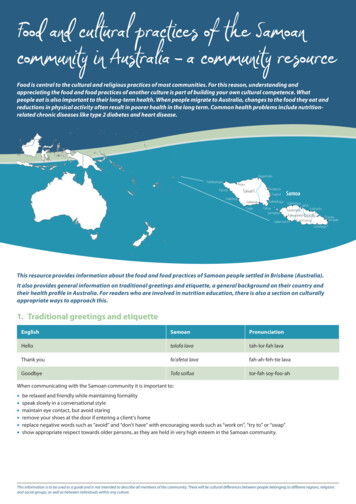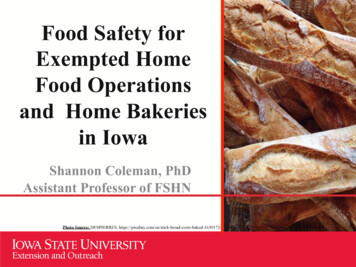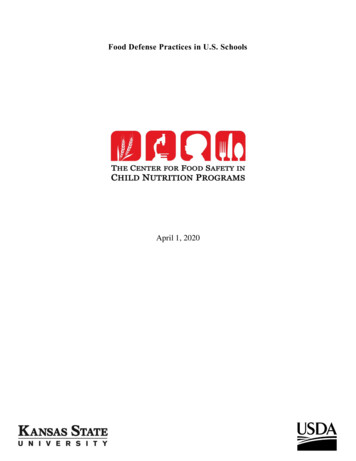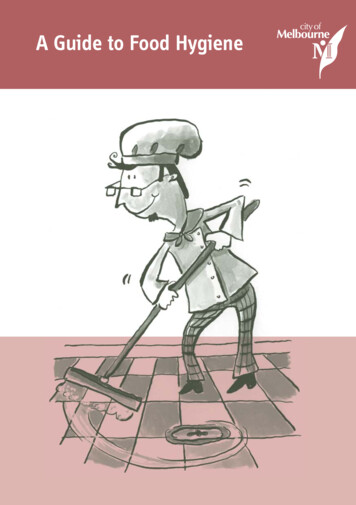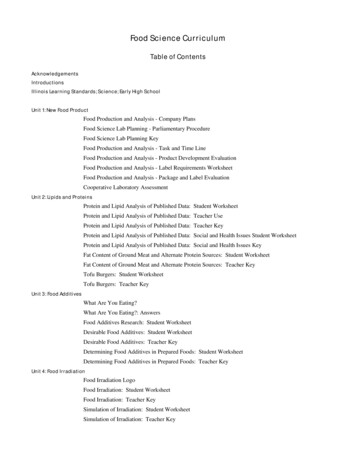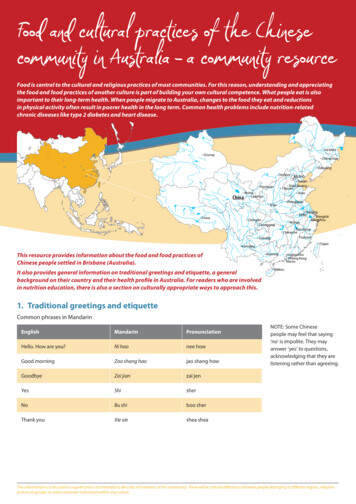
Transcription
Food and cultural practices of the Chinesecommunity in Australia – a community resourceFood is central to the cultural and religious practices of most communities. For this reason, understanding and appreciatingthe food and food practices of another culture is part of building your own cultural competence. What people eat is alsoimportant to their long-term health. When people migrate to Australia, changes to the food they eat and reductionsin physical activity often result in poorer health in the long term. Common health problems include nutrition-relatedchronic diseases like type 2 diabetes and heart Hohhot yángTaipeiKūnmíngThis resource provides information about the food and food practices ofChinese people settled in Brisbane (Australia).It also provides general information on traditional greetings and etiquette, a generalbackground on their country and their health profile in Australia. For readers who are involvedin nutrition education, there is also a section on culturally appropriate ways to approach this.NánníngGuăngzhōuHong KongMacauHăikŏu1. Traditional greetings and etiquetteCommon phrases in MandarinEnglishMandarinPronunciationHello. How are you?Ni haonee howGood morningZao shang haojao shang howGoodbyeZai jianzai jenYesShisherNoBu shiboo sherThank youXie xieshea sheaNOTE: Some Chinesepeople may feel that saying‘no’ is impolite. They mayanswer ‘yes’ to questions,acknowledging that they arelistening rather than agreeing.This information is to be used as a guide and is not intended to describe all members of the community. There will be cultural differences between people belonging to different regions, religionsand social groups, as well as between individuals within any culture.
2. Cultural information and migration historyEthnicityThere are around 20 ethnic groups in China, with 91.6% of the population identifying as Han Chinese and 1.3%identifying as Zhuang. Other ethnic groups make up the remaining 7.1% of the population.1ReligionIn 2011, the major religions amongst Chinese-born people were Buddhism and Catholicism. Approximately 63.2%didn’t follow a religion.2LanguageThe main languages spoken at home by Chinese-born people in Australia are Mandarin and Cantonese. 3 Othermajor Chinese languages/dialects include Hokkien, Hakka, Shanghainese (Wu) and Teo Chew.1,4 There are twowritten forms of the Chinese language: Traditional and Simplified.Migration historyChinese immigration to Australia commenced almost 200 years ago, until it was restricted by the White AustraliaPolicy. This policy was abolished in 1973 and was followed by a large increase in the number of Chinese migrantssettling in Australia. In the 1980s, Australia began promoting education to fee-paying overseas students, resultingin an increase in the numbers of Chinese people settling in Australia, and this continues to increase. 5Many people from a Chinese background migrate to Australia from a number of different countries such as China,Hong Kong, Malaysia, Singapore, Vietnam, Cambodia, Indonesia and others. Therefore, people from a Chinesebackground may have other cultural influences on their diet.Gender rolesWithin the Chinese community there are no clear or specific gender roles. Gender roles around food preparation,cooking and shopping differ between families and can be dependent on living arrangements. Gender roles seemto be determined by individual family preference rather than cultural influence.Household sizeIn 2010, the average size of the family household in China was 3.1 persons.6 This information is unknown for Chinesepeople living in Australia; however, household composition is available. In Australia, 2011, 70.9% of people bornin China lived in one-family households, 5.1% lived in multiple-family households, 11.8% lived in single-personhouseholds, and 12.3% lived in group households.3Population inAustraliaIn 2011, 866,200 people reported having Chinese ancestry.7 At the 2011 Census, 319,969 Chinese-born (excludingSARs* and Taiwan-born) people were living in Australia. 3 The largest population of Chinese-born people lived inNSW (156,034), followed by Victoria (93,896) and Queensland (27,036)2, and populations were concentrated in largecities such as Sydney, Melbourne and Brisbane.8* Special Administrative Regions of China such as Hong Kong and Macau.3. Health profile in AustraliaLife expectancyIn China, the life expectancy is approximately 75 years.9 Life expectancy is higher for women than men. Australianlife expectancy for Chinese migrants is approximately 82 years.9New arrivalsIn 2011, Chinese people were the third-largest group of overseas-born residents, contributing to 1.8% (319,000) ofAustralia’s population.10 Chinese migrants are considered to be relatively new arrivals to the country, with medianlength of residence being eight years. Chinese migrants live in highly urbanised areas in Australia.10Chronic diseaseIn China, chronic disease is thought to make up 79% of all deaths – 33% from cardiovascular disease, 17% fromchronic respiratory disease, 20% from cancer, 1% from diabetes and 8% from other chronic diseases. Risk factorsinclude diet, physical activity and the use of tobacco products.112Food and cultural practices of the Chinese community in Australia – a community resourceThis information is to be used as a guide and is not intended to describe all members of the community. There will be cultural differences between people belonging to different regions, religionsand social groups, as well as between individuals within any culture.
3. Health profile in Australia – continuedOral healthIn Australia, many people from a culturally and linguistically diverse background can experience difficulties inaccessing dental services, as with other health services, and therefore may experience negative effects on their oralhealth.12 Further information about the oral health of people with a Chinese background living in Australia is unknown.In China, oral health practices vary significantly according to urbanisation and province. Knowledge of causes andprevention of dental diseases can be low. Some people from a Chinese background may pay no attention to signsof dental caries if there is no pain.13Social determinantsof health and otherinfluencesPoor English language skills may deter some Chinese migrants from using mainstream healthcare services. Thisgroup may also be at risk of poorer social and economic outcomes, which may further impact on their ability toaccess healthcare.4. Traditional food and food practicesChina is a very diverse country with a large number of regions and a mix of urban and rural populations. There are six main regions, andfood preparation is distinct to each of these regions: Peking (Beijing), Canton, Sichuan, Shanghai, Hokkien and Northern China. Due to thedifferences between regions, the information in this guide may not be applicable to all Chinese people.Religious and cultural influencesIn Chinese communities living in Australia, religion rarely impacts upon diet. The British colonisation of Hong Kong from 1898 to 1997 has ledto slight westernisation of some food practices. Some people with a Chinese background may have grown up in countries other than Chinaand may have other cultural influences on diet.Traditional meals and snacksBreakfastHot foods such as rice porridge (congee), noodles, dim sum, dumplings, steamed buns, pickles, egg, meat or fishare eaten. People from Northern China may have pickled vegetables and roasted peanuts with congee.Main and othermealsLunch may comprise of hot foods such as rice or noodles and two to three dishes such as soup, a meat dish, vegetableor tofu dish. Each dish is prepared separately so that it is easy to share. In China, a sandwich is not considered to bea meal.Dinner is generally considered to be the main meal. It can be made up of hot foods similar to lunch but with extradishes.Fruit andvegetablesCommonly eaten vegetables include wombok (Chinese cabbage), bok choy, pak choy, gai lan (Chinese broccoli),choy sum, baby corn, cucumber and tomato.Common fruits include durian, star fruit, dragon fruit, longan, oranges, lychees, grapes, apples, mandarins,peaches, rambutans, apricots, pineapples and bananas.SnacksPackaged foods such as biscuits or chips are commonly eaten, as well as street foods such as steamed buns, meatskewers or noodles.BeveragesHot drinks such as Chinese green tea, coffee and tea are commonly consumed.It is uncommon for people with a Chinese background to drink alcohol frequently or in large amounts. If consumed,wine and beer may be preferred types of alcohol.Celebration foodsand religious foodpracticesMost special occasions will include some form of traditional foods, which are shared with the whole family.Chinese New Year is the most important event and many dishes such as chicken, fish and seafood are served inlarge portions to be shared. Dishes served on such occasions may convey a particular meaning, such as bringingwealth and health in the coming year. It is also common on traditional holidays or special occasions to consumecakes from glutinous rice and mooncake at the Mid-Autumn festival (see table below for description). Religionrarely impacts on diet in China.Food and cultural practices of the Chinese community in Australia – a community resource3This information is to be used as a guide and is not intended to describe all members of the community. There will be cultural differences between people belonging to different regions, religionsand social groups, as well as between individuals within any culture.
Common traditional foodsRoasted Peking duckThis is a famous dish from Beijing. The duck skin and meat areusually sliced into small pieces and eaten with scallion, cucumberand sweet bean sauce, and rolled up in a pancake.Sweet and sour porkPork is diced and stir-fried in sweet and sour sauce made up ofsugar, ketchup, vinegar and soy sauce. This is usually cooked withcapsicum and pineapple.Mapo tofuSilken tofu is accompanied by minced ground beef and cooked ina spicy and hot pepper seasoning.DumplingsDumplings are often filled with beef, pork or chives. They can besteamed or fried and are usually dipped in black vinegar mixedwith chilli sauce.MooncakesThese round pastries are approximately 10 cm in diameter and3 cm high with a thin crust. They are usually filled with red bean orlotus seed paste but may also contain yolks from salted duck eggs.They are eaten during the Mid‑Autumn Festival and, more recently,used as a present for business clients and relatives.4Food and cultural practices of the Chinese community in Australia – a community resourceThis information is to be used as a guide and is not intended to describe all members of the community. There will be cultural differences between people belonging to different regions, religionsand social groups, as well as between individuals within any culture.
5. Food habits in AustraliaFood practicesCommon foods: Common seasonings include light soy sauce, dark soy sauce (fermented for longer), sesame oil,five-spice powder, oyster sauce, rice wine, ginger and garlic. Potato starch is used for thickening and coating meator fish before frying. Tapioca starch and corn flour can be a substitute.14Meal patterns: Consumption of three meals per day is common (breakfast, lunch and dinner). Dinner is usually themain meal.Eating practices: It is common to share a number of dishes at the main meal. There are usually a variety of bowlsand plates for rice, soup and vegetable/meat dishes. Ingredients for dishes are cut into small pieces so there is noneed for cutting at the table. The entire family living in the household eats the main meal together at the table,and everyone starts the meal at the same time. Chopsticks, knives and forks are the common eating utensils used.Flat-bottomed spoons are used to eat soup.Adaptations todiet in AustraliaSubstitute foods: Access to basic traditional foods is quite high, but the variety of Chinese food items such asvegetables is much lower and may be difficult to source; hence many older Chinese migrants grow their ownChinese vegetables at home to ensure variety.Changes to diet: Some Chinese may now consume toast for breakfast and a sandwich or salad for lunch, anddairy consumption may have increased after migration to Australia. Fresh fish consumption may decrease aftermigration to Australia due to a decrease in its availability. Some snack foods may be adopted after moving toAustralia, including potato chips, corn chips and chocolate.Cooking methodsSteaming, stir-frying, frying and boiling. Traditional Chinese food may have additional oil added during cooking.Oven use may increase in Australia. Cooking in ovens is uncommon in China.Shopping/mealpreparationShopping and meal preparation may vary within each household and between families. The older members of thefamily are usually responsible for shopping and meal preparation (mother, father, grandmother and grandfather).Food in pregnancyPregnant women are encouraged to continue to work up to the end of pregnancy as it is believed to ensure aneasier birth. Some mothers are superstitious and will adhere to a strict diet during pregnancy, which means theexclusion of a number of different foods; e.g. watermelon is considered too ‘cold’, lychee is considered too ‘hot’,and crab and pawpaw are thought to cause birth defects. Pregnant women avoid ‘cold’ and raw foods.Breastfeeding andfirst foodsAfter the birth, mother and baby may observe a period of confinement, refrain from eating ‘cold’ foods and haveto be kept warm. They are usually cared for by the mother-in-law.Breastfeeding: There is limited information regarding breastfeeding rates of Chinese women in Australia.In 2006, of 282 Chinese who gave birth in Queensland Health facilities, 68% exclusively breastfed, 24% breastfedand formula-fed and 8% exclusively formula-fed.15In China, colostrum is often discarded and breastfeeding may not begin until milk has come in. Approximately 98%of infants are breastfed at some time, and 59.4% of mothers initiate breastfeeding early (within one hour of birth).Rates of exclusive breastfeeding at six months and continued breastfeeding at one and two years of age are low.16Mothers tend to supplement babies with formula after a few months, as chubby babies are considered strong andhealthy.Introduction of solids: Some common first foods that babies are fed include rice porridge, stewed fruit, mashedmeat and vegetables, and infant rice cereal fortified with a range of vitamins and minerals (e.g. Nestum InfantCereal).Food and cultural practices of the Chinese community in Australia – a community resource5This information is to be used as a guide and is not intended to describe all members of the community. There will be cultural differences between people belonging to different regions, religionsand social groups, as well as between individuals within any culture.
6. Working with Chinese community membersUsing aninterpreter Ask Chinese community members or groups if they would prefer (or benefit from) having an interpreter present(rather than asking if they speak English). Be sure to confirm the language preference of the individual or group. This is important because many distinctdialects are spoken. It is important that a trained and registered interpreter be used when required. The use of children, other familymembers or friends is not advisable. Health and other services must consider the potential legal consequencesof adverse outcomes when using unaccredited people to ‘interpret’ if an accredited interpreter is available. If you have limited experience working with an interpreter, it is recommended that you improve these skills priorto meeting with community members. There are many online orientation courses available, and QueenslandHealth has produced guidelines (available here) for working with interpreters.Literacy levelsWithin China, literacy rates are very high, with only 4% of the population reported as being illiterate.6 Literacy rates ofChinese migrants vary, with skilled migrants requiring literacy in English to enter Australia. This is not a requirementof business migrants.Be aware that Family is the core of Chinese culture. Community members, especially females, may prefer to bring a relative orfriend to an appointment or group activity. Intergenerational differences exist, with older Chinese migrants often preferring printed materials while youngerpeople may prefer web-based information and activities.Motivating factorsfor a healthylifestyleMany Chinese people are motivated to live a healthy lifestyle for their individual wellbeing, the prevention ofillness, weight maintenance and to live longer. The Chinese belief in the importance of family may also be a majormotivator for staying healthy.CommunicationstyleDepending on the topic, older people may prefer group interactions to meeting with health workers individually.Health beliefsHealth beliefs of people with a Chinese background who were born in Australia may be similar to Australians.Some Chinese people will use Chinese medical treatments including Chinese herbs, acupuncture and acupressure.Due to the reliance on family members when ill and because main meals are commonly shared, it may benecessary to make dietary recommendations suitable for the whole family.Many Chinese people consider health to mean a state of harmony between the forces of Yin (negative energy,cold) and Yang (positive energy, hot). Illness is perceived to be a result of disharmony or imbalance between theseforces, and interventions seek to correct imbalances and restore harmony.17Food, illness and medications are classified as ‘hot’ or ‘cold’ according to the effects on the body, not theirtemperature or taste.18 Chinese people may find it difficult to modify their diet if the recommendations clashwith hot (heating, warming) and cold (cooling) food beliefs.6Food and cultural practices of the Chinese community in Australia – a community resourceThis information is to be used as a guide and is not intended to describe all members of the community. There will be cultural differences between people belonging to different regions, religionsand social groups, as well as between individuals within any culture.
6. Working with Chinese community members – continuedHealth beliefs –continuedHot (heating, warming) and cold (cooling) foodsFoods are either hot (warming), cold (cooling) or neutral (no effect). It is common for Chinese people to avoidconsumption of too many hot foods or too many cold foods at the same time. Neutral foods are neither hot norcold and are suitable for anybody.Warming foodsCooling foodsNeutral efruitPawpawPeachOrangePineappleGlutinous riceLemonWhite riceButterTofuCow’s milkOnionSoy beanOlivesPumpkinGreen cumberFishPrawnsGreen leafy vegetablesBeefLambEggplantPorkAdditional resources Queensland Health Working with Interpreters: Guidelines reters/guidelines int.pdf) To find out more about multicultural health, Queensland Health’s Multicultural Health page has information for the public and for healthworkers, including the Multicultural health framework. Go to .asp To source or contact an interpreter, please visit eters/QHIS work.aspReferences1. Queensland Health and Multicultural Services. Community profiles for health care providers: Chinese Australians [Internet]. QueenslandHealth; 2011 [cited 2014 April 15]. Available from: http://www.health.qld.gov.au/multicultural/health workers/Chinese2011.pdf2. Census, QuickStats: All people-usual residents: People in Australia who were born in China Australian Bureau of Statistics [Internet]; 2013.Australia: Australian Bureau of Statistics [cited 2014 April 19]. Available from: http://www.censusdata.abs.gov.au/census services/getproduct/census/2011/quickstat/6101 03. Census, QuickStats: All people-usual residents: Australia [Internet]; 2013. Australia: Australian Bureau of Statistics [cited 2014 April 19].Available from: http://www.censusdata.abs.gov.au/census services/getproduct/census/2011/quickstat/04. Multicultural equity and access program. Chinese speaking communities profile [Internet]. Melbourne: Multicultural equity and accessprogram; 2010 [cited 2014 April 26]. Available from: /CulturalProfiles/ChineseCulturalProfile2010.pdf5. Inglis, C. Australia and China: Linked by Migration [Internet]. The University of Sydney; [date unknown] [cited 2014 April 30]. Available from:http://sydney.edu.au/china studies centre/china express/issue 2/features/australia and china.shtmlFood and cultural practices of the Chinese community in Australia – a community resource7This information is to be used as a guide and is not intended to describe all members of the community. There will be cultural differences between people belonging to different regions, religionsand social groups, as well as between individuals within any culture.
6. Major Figures of the 2010 Population Census [Internet]. China: China National Bureau of Statistics China; 2011 [cited 2014 April 23]. Availablefrom: qu/201104/t20110428 61452.html7. Australian Bureau of Statistics. Reflecting a Nation: Stories from the 2011 Census [Internet]. Australian Bureau of Statistics; 2013 [cited 2014April 18]. Available from: 1.0main features902012-20138. Department of Immigration and Citizenship Community. Information Summary: China-born [Internet]. Australian Government; 2014 [cited2014 April 19]. Available from: s/02 2014/china.pdf9. Central Intelligence Agency (CIA). The world fact book [Internet]. CIA; 2010 [cited 2014 April 18]. Available from: -factbook/10. Australian Bureau of Statistics. Where do migrants live? Australian social trends [Internet]. Australian Bureau of Statistics; 2014 [cited 2014April 19]. Available from: 2.0main features10201411. World Health Organisation. The Impact of Chronic Disease in China [Internet]. WHO; 2005. [cited 2014 April 18]. Available from: http://www.who.int/chp/chronic disease report/media/china.pdf12. Dental Health Services Victoria. Culturally and Linguistically Diverse Communities: Resource Kit. [Internet]. Victoria: Dental Health ServicesVictoria; 2010 [cited 2014 April 25]. Available from: https://www.dhsv.org.au/ data/assets/pdf file/0013/3226/cald-kit.pdf13. Zhu, L., Petersen, P., Wang, H., Bian, J. & Zhang, B. Oral health knowledge, attitudes and behaviour of adults in China. International DentalJournal [Internet]; 2005 [cited 2014 April 27] 55(4): [about 237 pp]. Available from: http://www.who.int/oral health/publications/orh IDJKAP adults china.pdf14. SBS Food Safari: Chinese Cuisine [Internet]. SBS; 2014 [cited 2014 April 20]. Available from 2/n/Chinese15. Queensland Health and Multicultural Services. Chinese Ethnicity and Background: Pregnancy Profile [Internet]. Queensland Health; [dateunknown] [cited 2014 April 30]. Available from: http://www.health.qld.gov.au/multicultural/health workers/chinese-preg-prof.pdf16. Guo, S., Fu, X., Scherpbier, R., Wang, Y., Zhou, H., Wang, X. & Hipgrave, D. Breast feeding rates in central and western China in 2010:implications for child and population health. Bulletin of the World Health Organisation [Internet]; 2012 [cited 2014 April 30] 91(5):[about 323 pp]. Available from: http://www.who.int/bulletin/volumes/91/5/en/ DOI: http://dx.doi.org/10.2471/BLT.12.11131017. Ho, E., Tran, H. & Chesla, A. Assessing the cultural in culturally sensitive printed patient-education materials for Chinese Americans with type2 diabetes. Health Communication [Internet]; 2014 [cited 2014 April 8] 19(4): [about 4 pp]. Available from: 6.2013.835216#preview DOI: http://dx.doi.org/10.1080/10410236.2013.83521618. Stokes, S. & Pan, C. Health and health care of Chinese American older adults [Internet]. Stanford: Stanford University School of Medicine;2010 [cited 2014 April 29]. Available from: wnloads/chineseAcknowledgementsThis resource has been developed in partnership with Diabetes Queensland as part of a student placement supervised by Alison Bennett andsupported by Michelle Tong, both Diabetes Queensland diabetes dietitians. We wish to thank QUT students Jessica Phillips and Lilian BisshopCampbell for their hard work in the development of this resource, and Rae Zhang and Breanne Hosking for its editing and formatting.Thanks also to the members of the Chinese community living in the Greater Metro Brisbane region for sharing their traditional foods and practices.For more information contact:Access and Capacity-building TeamMetro South Healthaccess&capacity@health.qld.gov.au State of Queensland (Metro South Health) 2015Please note: The web links in this document were current as at March 2015. Use of search engines is recommended if the page is not found.8Food and cultural practices of the Chinese community in Australia – a community resourceThis information is to be used as a guide and is not intended to describe all members of the community. There will be cultural differences between people belonging to different regions, religionsand social groups, as well as between individuals within any culture.
2 Food and cultural practices of the Chinese community in Australia - a community resource This information is to be used as a guide and is not intended to describe all members of the community. There will be cultural differences between people belonging to different regions, religions


